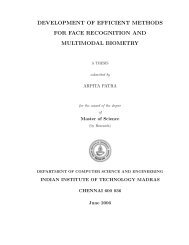The Enigma of Group Theory - Department of Computer Science ...
The Enigma of Group Theory - Department of Computer Science ...
The Enigma of Group Theory - Department of Computer Science ...
Create successful ePaper yourself
Turn your PDF publications into a flip-book with our unique Google optimized e-Paper software.
http://www.cs.bris.ac.uk University <strong>of</strong> Bristol, <strong>Department</strong> <strong>of</strong> <strong>Computer</strong> <strong>Science</strong><br />
Fact 1 Two permutations σ and τ which are conjugate, i.e. for which σ = λ · τ · λ −1 for some permutation λ, have<br />
the same cycle structure.<br />
We define the support <strong>of</strong> a permutation to be the set <strong>of</strong> letters which are not fixed by the permutation.<br />
Hence, if σ acts on the set <strong>of</strong> letters L, then as usual we denote by L σ the set <strong>of</strong> fixed points and hence<br />
the support is given by<br />
L \ L σ .<br />
Fact 2 If two permutations, with the same support, consist only <strong>of</strong> disjoint transpositions then their product<br />
contains an even number <strong>of</strong> disjoint cycles <strong>of</strong> the same lengths.<br />
Fact 3 If a permutation with support an even number <strong>of</strong> symbols has an even number <strong>of</strong> disjoint cycles <strong>of</strong> the same<br />
lengths, then the permutation can be written as a product <strong>of</strong> two permutations each <strong>of</strong> which consists <strong>of</strong> disjoint<br />
transpositions.<br />
In many places we need an algorithm to solve the following problem: Given αi, βi ∈ S26, for i = 1, . . . , m<br />
find γ ∈ S26 such that<br />
αi = γ −1 · βi · γ for i = 1 . . . , m.<br />
Note, there could be many such solutions γ, but in the situations we will apply it we expect there to be<br />
only a few. For example suppose we have one such equation with<br />
α1 = (AFCNE)(BWXHUJOG)(DVIQZ)(KLMYTRPS),<br />
β1 = (AEYSXWUJ)(BFZNO)(CDPKQ)(GHIVLMRT)<br />
We need to determine the structure <strong>of</strong> the permutation γ such that<br />
α1 = γ −1 · β1 · γ.<br />
We first look at what should A map to under γ. If A γ = B, then from α1 and β1 we must have E γ = W,<br />
which in turn implies Y γ = X. Carrying on in this way via a pruned depth first search [1] we can<br />
determine a set <strong>of</strong> possible values for γ. Such an algorithm is relatively simple to write down in a<br />
computer programming language, using a recursive procedure call [7]. It however <strong>of</strong> course been a bit<br />
<strong>of</strong> a pain to do this by hand, as one would need to in the 1930’s and 1940’s.<br />
2 An equation for the <strong>Enigma</strong><br />
To aid our discussion in later sections we now describe the <strong>Enigma</strong> machine as a permutation equation.<br />
We first assume a canonical map between letters and the integers {0, 1, . . . , 25} such that 0 = A, 1 = B, etc<br />
and we assume a standard three wheel <strong>Enigma</strong> machine.<br />
<strong>The</strong> wheel which turns the fastest we shall call rotor one, whilst the one which turns the slowest we<br />
shall call rotor three. This means that when looking at a real machine rotor three is the left most rotor<br />
and rotor one is the right most rotor. This can cause confusion (especially when reading day/message<br />
settings), so please keep this in mind.<br />
<strong>The</strong> basic permutations which make up the <strong>Enigma</strong> machine are as follows:<br />
2.1 Choice <strong>of</strong> rotors<br />
We assume that the three rotors are chosen from the following set <strong>of</strong> five rotors. We present these rotors<br />
in cycle notation, but they are the commonly labelled rotors I, II, III, IV and V used in the actual <strong>Enigma</strong><br />
machines, which were given earlier. Each rotor also has a different notch position which controls how<br />
the stepping <strong>of</strong> one rotor drives the stepping <strong>of</strong> the others.<br />
Rotor Notch<br />
Permutation Representation Position<br />
I (AELTPHQXRU)(BKNW)(CMOY)(DFG)(IV)(JZ) 16 = Q<br />
II (BJ)(CDKLHUP)(ESZ)(FIXVYOMW)(GR)(NT) 4 = E<br />
III (ABDHPEJT)(CFLVMZOYQIRWUKXSG) 21 = V<br />
IV (AEPLIYWCOXMRFZBSTGJQNH)(DV)(KU) 9 = J<br />
V (AVOLDRWFIUQ)(BZKSMNHYC)(EGTJPX) 25 = Z<br />
7










